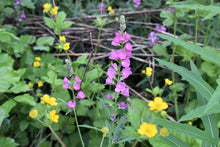
Sidalcea asprella ssp. virgata (syn Sidalcea malviflora ssp. virgata / Sidalcea virgata)
Rose checkermallow, or dwarf checkermallow, is a vibrant pink wildflower that is a high-quality nectar source for the endangered Fender’s blue butterfly and a host plant for many native butterflies, such as the painted lady. Each spring, its hollyhock-like flowers stand gorgeously on erect spikes 2'-3' tall, atop mounds of attractive, dark green foliage. It can even put on a second floral show with a little extra care (see below).
- Plant type/canopy layer: deciduous, perennial, herbaceous plant
- Size at maturity: 24-36" tall,12-24" wide
- Light requirements: full sun, part sun/part shade
- Moisture requirements: prefers moist, well-drained, but can tolerate drought
- Growth rate/ease: fast growing, easy to grow
- Bloom time: April - June (cut back and irrigate for more late-season flowers)
- Wildlife support: flowers attract and provide a high-quality nectar source for hummingbirds, bees, adult butterflies, including the Taylor’s Checkerspot and endangered Fender’s Blue, and other insect pollinators; overall plant is a caterpillar host plant and larval food source for native moths and butterflies, such as the painted lady, Gray Hairstreak and Checkered Skipper
- Native range: commonly seen growing on grassy hillsides, wetlands, open meadows, and along roadsides in the Willamette Valley, central and southern Oregon, the Coast and the Cascade Ranges, as well as one isolated community in an open prairie of southern Washington, where it is listed endangered. Portland Plant List – no.
- Special features & uses: beneficial insect and pollinator favorite; drought tolerant landscape uses include meadowscapes and pollinator gardens
Gardening with Rose Checkermallow: This lovely wildflower adds a sassy pop of color to pollinator gardens, meadowscapes, and borders. It favors full to mostly sunny areas with moist, well-drained soils. That said, it proves to be quite hardy and drought tolerant, mostly disease/pest free, and therefore long-lived. After it finishes blooming in early summer, cut it back and water regularly to achieve a second, late-season bloom! Reseeds easily. Was historically maintained by fire.
Seeding Instructions: Sow seeds directly into prepared, weed-free soil or small flats/containers in fall, since this species usually needs 45-90 days of cold, moist dormancy before seeds will germinate in spring. Each packet contains approx 80 seeds.
Photo Credit 1 (buds, raindrops): © Gail A Baker, some rights reserved (CC-BY)
Photo Credit 2 (foliage): "Sidalcea virgata" by Mary Lynn Roush is marked with CC0 1.0.
Photo Credit 3 (flowers, buds): "Sidalcea virgata" by James Adney is marked with CC0 1.0.
Photo Credits 4 (flowering habit): Tara Lemezis, Tiny Seed Photography
Photo Credits 5 & 6 (with avens, in a habitat garden): Nikkie West, Sparrowhawk Native Plants
Photo Credit 7 (in the wild): "Sidalcea virgata" by Kate Manning is marked with CC0 1.0.













